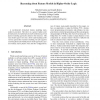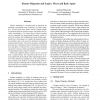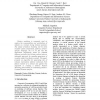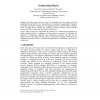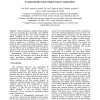AIEDAM
2006
14 years 8 months ago
2006
In current commercial feature modeling systems, support for direct manipulation of features is not commonly available. This is partly due to the strong reliance of such systems on...
SPLC
2007
14 years 9 months ago
2007
A mechanically formalized feature modeling metamodel is presented. This theory is a generic higher-order formalization of a mathematical model synthesizing several feature modelin...
SPLC
2007
14 years 9 months ago
2007
Feature modeling is a notation and an approach for modeling commonality and variability in product families. In their basic form, feature models contain mandatory/optional feature...
SERP
2003
14 years 9 months ago
2003
Feature modeling is commonly used to capture the commonalities and variabilities of systems in a domain during Domain Analysis. The output of feature modeling will be some reusabl...
SPLC
2004
14 years 9 months ago
2004
Feature modeling is an important approach to capturing commonalities and variabilities in system families and product lines. In this paper, we propose a cardinality-based notation ...
ECOOP
1999
Springer
15 years 13 days ago
1999
Springer
This paper argues that the current OO technology does not support reuse and configurability in an effective way. This problem can be addressed by augmenting OO analysis and design ...
ECBS
2003
IEEE
15 years 1 months ago
2003
IEEE
System families are a form of high level reuse of development assets in a specific problem domain, by making use of commonalities and variabilities. To represent assets belonging ...
SEKE
2004
Springer
15 years 1 months ago
2004
Springer
Feature modeling is a popular domain analysis method for describing the commonality and variability among the domain products. The current formalisms of feature modelling do not ha...
JIT
2004
Springer
15 years 1 months ago
2004
Springer
Feature modeling, a conceptual domain modeling technique used mainly in domain engineering, proved as useful for representing configurability of concepts by dealing explicitly wit...
ICSR
2004
Springer
15 years 1 months ago
2004
Springer
Analyzing commonalities and variabilities among products of a product line is an essential activity for product line asset development. A feature-oriented approach to commonality a...

